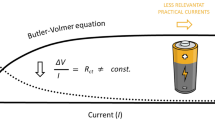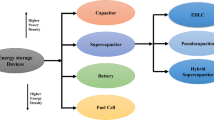Abstract
A mathematical model was developed to describe the performance of nanoparticulate mixed oxide pseudocapacitors based on RuO2–MO2 (M being another suitable transition metal) under galvanostatic charge/discharge regime. Both double layer and faradaic processes were taken into account. The effects of the active material’s particle size and composition were examined. Furthermore, the influence of discharge current on the extents of double layer and faradaic contributions was analyzed. The model analysis showed that the energy density declined upon increasing the volume fraction of larger particles.









Similar content being viewed by others
References
Conway BE (1999) Electrochemical supercapacitors: scientific fundamentals and technological applications. Kluwer, New York
Zheng JP, Cygan PJ, Jow TR (1995) J Electrochem Soc 142:2699
Jow TR, Zheng JP (1998) J Electrochem Soc 145:49
Hu CC, Chen WC (2004) Electrochim Acta 49:3469
Sugimoto W, Iwata H, Yokoshima K, Murakami Y, Takasu Y (2005) J Phys Chem B 109:7330
Juodkazis K, Juodkazytė J, Šukienė V, Grigucevičienė A, Selskis A (2007) On the charge storage mechanism at RuO2/0.5 M H2SO4 interface. J Solid State Electrochem. DOI 10.1007/s10008-007-0476-0
Hu CC, Wang CC (2003) J Electrochem Soc 150:A1079
Prasad KR, Miura N (2004) J Power Sources 135:354
Chen YS, Hu CC, Wu YT (2004) J Solid State Electrochem 8:467
Zolfaghari A, Ataherian F, Ghaemi M, Gholami A (2007) Electrochim Acta 52:2806
Liu KC, Anderson MA (1996) J Electrochem Soc 143:124
Lin C, Ritter JA, Popov BN (1998) J Electrochem Soc 145:4097
Xu MW, Bao SJ, Li HL (2007) J Solid State Electrochem 11:372
Yong-gang W, Xiao-gang Z (2004) Electrochim Acta 49:1957
Liu XM, Zhang XG (2004) Electrochim Acta 49:229
Kuo SL, Wu NL (2003) Electrochem Solid-State Lett 6:A85
Jeong YU, Manthiram A (2000) Electrochem Solid-State Lett 3:205
Chen YS, Hu CC (2003) Electrochem Solid-State Lett 6:A210
Prasad KR, Miura N (2004) Electrochemistry Communications 6:1004
Nakayama M, Tanaka A, Sato Y, Tonosaki T, Ogura K (2005) Langmuir 21:5907
Kuan-Xin H, Quan-Fu W, Xiao-Gang Z (2006) J Electrochem Soc 153:A1568
Liang YY, Bao SJ, Li HL (2007) J Solid State Electrochem 11:571
Tao F, Shen Y, Liang Y, Li H (2007) J Solid State Electrochem 11:853
Zhao Y, Liu L, Xu J, Yanh J, Yan M, Jiang Z (2007) J Solid State Electrochem 11:283
Su LH, Zhang XG, Liu Y (2007) Electrochemical performance of Co–Al layered double hydroxide nanosheets mixed with multiwall carbon nanotubes. J Solid State Electrochem. DOI 10.1007/s10008-007-0455-5
Wang Y, Yuan A, Wang X (2007) Pseudocapacitive behaviors of nanostructured manganese dioxide/carbon nanotubes composite electrodes in mild aqueous electrolytes: effects of electrolytes and current collectors. J Solid State Electrochem. DOI 10.1007/s10008-007-0445-7
Hong JI, Yeo IH, Paik WK (2001) J Electrochem Soc 148:A156
Mallouki M, Tran-Van F, Sarrazin C, Simon P, Daffos B, De A, Chevrot C, Fauvarque JF (2007) J Solid State Electrochem 11:398
Lin C, Ritter JA, Popov BN, White RE (1999) J Electrochem Soc 146:3168
Lin C, Popov BN, Ploehn HJ (2000) J Electrochem Soc 149:A167
Farsi H, Gobal F (2007) J Solid State Electrochem 11:1085
Nagarajan GS, Van Zee JW, Spotnitz RM (1998) J Electrochem Soc 145:771
Yu AB, Zou RP, Standish N (1996) Ind Eng Chem Res 35:3730
Kim H, Popov BN (2003) J Electrochem Soc 150:A1153
Newman JS (2004) Electrochemical systems, 3rd edn. Prentice-Hall Inc., New York
White RE, Lorimer SE, Dardy R (1983) J Electrochem Soc 130:1123
J. W. Evans and P. Kar (2008) Notes on BAND and LISOLV. www.mse.berkeley.edu/Groups/Evans/pritish/BandandLisolvNotes.doc
Pillay B, Newman J (1996) J Electrochem Soc 143:3791
Pollak FH, O’Grady WE (1985) J Electrochem Soc 132:2385
Trasatti S, Lodi G (1980) Properties of conductive transition metal oxides with rutiel-type structure. In: Trasatti S (ed) Electrodes of conductive metalic oxides—part A. Elsevier, New York, pp 301–358
Darling HE (1964) J Chem Eng Data 9:421
Author information
Authors and Affiliations
Corresponding author
Additional information
This paper has been presented in IBA (International Battery Materials Association) 2007 Conference, Shenzhen, China.
Rights and permissions
About this article
Cite this article
Farsi, H., Gobal, F. A mathematical model of nanoparticulate mixed oxide pseudocapacitors; part I: model description and particle size effects. J Solid State Electrochem 13, 433–443 (2009). https://doi.org/10.1007/s10008-008-0576-5
Received:
Accepted:
Published:
Issue Date:
DOI: https://doi.org/10.1007/s10008-008-0576-5




